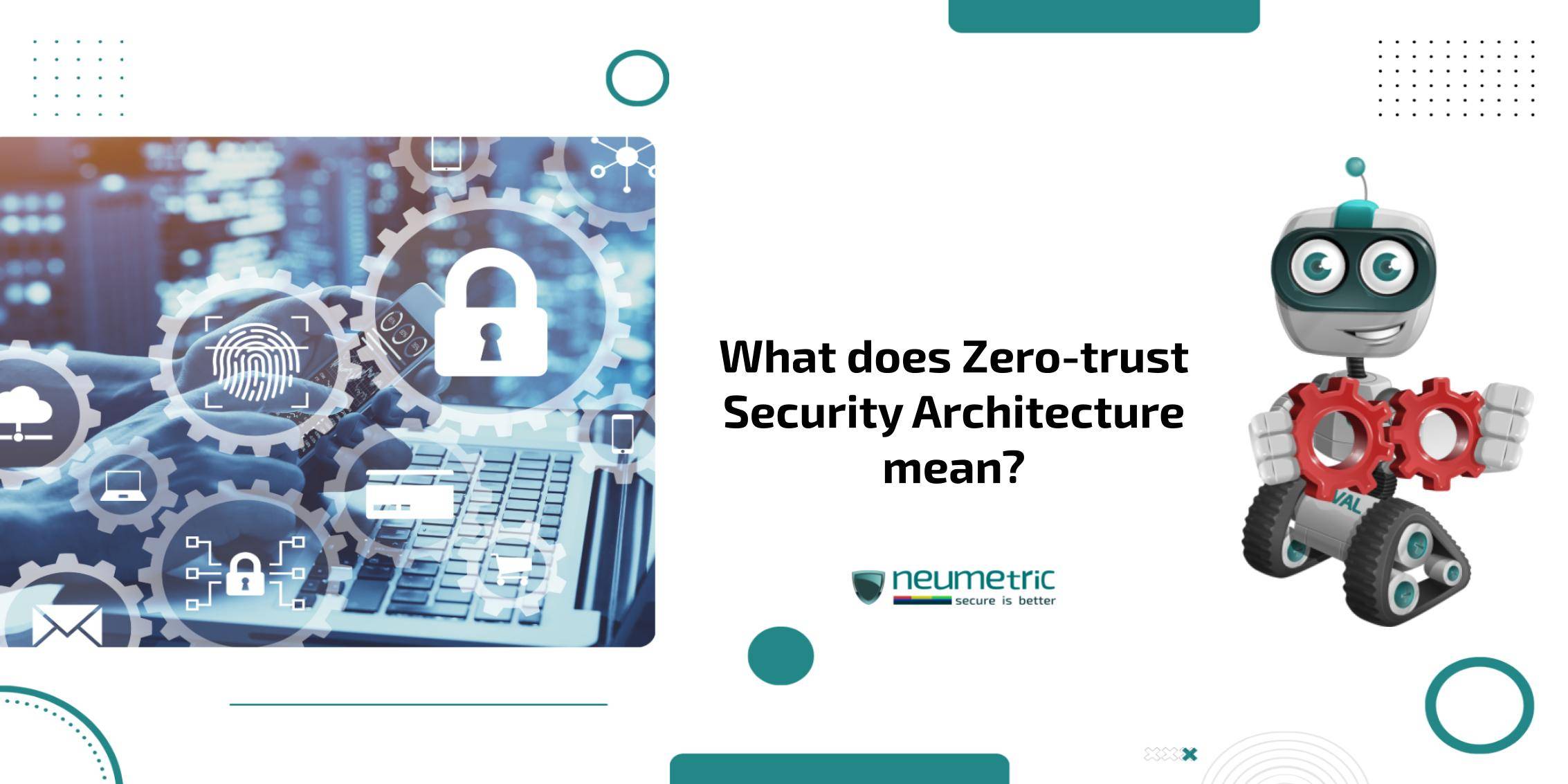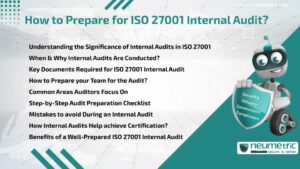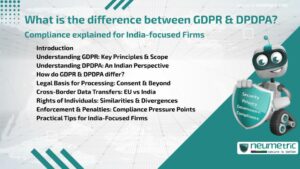Table of Contents
ToggleWhat does Zero-trust Security Architecture mean?
Introduction
In the rapidly evolving landscape of cybersecurity, traditional security models no longer provide adequate protection against sophisticated threats. This has led to the emergence of a paradigm-shifting approach known as Zero-Trust Security Architecture. This Journal aims to elucidate the core tenets of Zero-Trust and underscore its significance in contemporary security strategies.
Zero-Trust Architecture [ZTA] operates on the fundamental principle of “never trust, always verify.” Unlike traditional models that implicitly trust entities within the network perimeter, Zero-Trust challenges this assumption, treating every user, device & network component as potentially untrusted until proven otherwise.
The importance of Zero-Trust stems from its proactive stance in mitigating the risks posed by advanced cyber threats. In an era characterized by escalating cyber-attacks and increasingly sophisticated tactics employed by malicious actors, the traditional perimeter-based security model has become inadequate. Zero-Trust acknowledges the dynamic nature of the modern threat landscape and positions itself as a comprehensive and adaptive security approach.
One of the key aspects of Zero-Trust is the principle of least privilege access. This entails restricting access rights for users and systems to the minimum necessary for their specific tasks. By implementing this principle, Zero-Trust minimizes the potential impact of a security breach, even if unauthorized access is achieved.
The significance of Zero-Trust becomes evident in scenarios where the traditional security model falls short. With the proliferation of remote work and cloud-based services, the traditional perimeter is increasingly porous. Zero-Trust adapts to this shift by securing every user, device & data transaction, regardless of their location or network entry point.
Core Principles
In crafting a robust cybersecurity strategy, the core principles of Zero-Trust serve as the bedrock for safeguarding against evolving threats. Let’s delve into these foundational elements:
Verify Every User
Zero-Trust challenges the conventional belief that once inside the network, trust is implicit. Instead, it demands explicit verification for every user, every time. Multi-Factor Authentication [MFA] emerges as a pivotal player in this process, ensuring that accessing critical resources requires more than just a password. This heightened level of scrutiny extends further with continuous authentication, maintaining a persistent evaluation of a user’s identity throughout their session.
Least Privilege Access
Embracing the principle of least privilege access is a strategic move toward minimizing vulnerabilities. By restricting user permissions to the bare essentials necessary for their role organizations curtail the potential impact of a security breach. Role-Based Access Control [RBAC] becomes the linchpin, tailoring access permissions based on specific job roles. This measured approach not only fortifies security but also streamlines operational efficiency by ensuring users only access what is absolutely necessary.
Micro-Segmentation
Micro-Segmentation heralds a shift from the traditional flat network architecture. By breaking down the network into smaller, isolated segments organizations create virtual fortresses within their infrastructure. This proactive strategy impedes the lateral movement of cyber threats, limiting their ability to traverse the network. The compartmentalization of systems and applications under Micro-Segmentation empowers organizations with granular control over their network traffic, enhancing both security and monitoring capabilities.
In essence, these core principles of Zero-Trust collectively redefine the security paradigm, compelling organizations to question assumptions and adopt a proactive, layered approach to protect their digital assets.
Zero-Trust for Devices
In the ever-expanding digital landscape, where endpoints and mobile devices serve as crucial entry points, a Zero-Trust approach becomes imperative. Let’s explore how organizations fortify their defenses in this device-centric realm:
Endpoint and Mobile Security
- Endpoint Security: Embracing Zero-Trust involves acknowledging that endpoints are not inherently secure. Endpoint Detection and Response [EDR] take center stage in this domain. These proactive tools actively scan, detect & respond to potential threats on individual devices. By constantly monitoring endpoint activities, EDR ensures timely identification and mitigation of security risks, safeguarding against evolving threats.
- Mobile Security: With the proliferation of mobile devices in the workplace, securing them is paramount. Mobile Application Management [MAM] steps in as a key player, providing organizations with the means to manage and secure the applications on mobile devices. Additionally, the containerization of mobile apps ensures that corporate data remains isolated from personal data, offering an extra layer of protection against data breaches and unauthorized access.
A Zero-Trust approach for devices recognizes that security must extend beyond the traditional network perimeter. By implementing robust strategies for endpoint and mobile security organizations create a resilient defense, acknowledging the dynamic nature of modern work environments.
Network Security
In the era of heightened connectivity, securing the network itself becomes a pivotal aspect of a comprehensive cybersecurity strategy. Let’s delve into the key components of network security within the Zero-Trust framework:
Zero-Trust Networking
- Software-Defined Perimeters [SDP]: Zero-Trust Networking marks a departure from the traditional castle-and-moat approach. SDP plays a pivotal role by creating dynamic, on-demand perimeters around individual users and devices. By ensuring that network access is granted based on user authentication and device trustworthiness, SDP minimizes the attack surface and fortifies the network against unauthorized access.
- Secure Access Service Edge [SASE]: The integration of Zero-Trust principles with the concept of SASE further enhances network security. SASE combines network security functions with WAN capabilities to support the dynamic, secure access needs of organizations. This approach facilitates a more flexible and scalable network architecture, aligning with the principles of Zero-Trust Networking.
Encryption Everywhere
- Data in Transit: In a Zero-Trust environment, data is considered sensitive regardless of its location. Encryption of data in transit becomes a non-negotiable measure to protect information as it traverses the network. Secure Sockets Layer [SSL] and Transport Layer Security [TLS] protocols encrypt communication, ensuring that even if intercepted, the data remains indecipherable to unauthorized entities.
- Data at Rest: Extending the principle of encryption, securing data at rest is equally critical. Whether stored in databases, servers or endpoints, sensitive information should be encrypted to mitigate the impact of a potential breach. Robust encryption algorithms ensure that even if unauthorized access occurs, the data remains protected and unreadable.
Zero-Trust Network Security encompasses dynamic and proactive measures to fortify the very fabric of an organization’s connectivity. By leveraging Zero-Trust Networking strategies and implementing encryption ubiquitously organizations create resilient networks capable of withstanding the sophisticated tactics of modern cyber threats.
Implementing Zero-Trust in the Cloud
As organizations increasingly migrate their operations to cloud environments, implementing Zero-Trust becomes a cornerstone in ensuring robust cybersecurity. Let’s explore the practical aspects of deploying Zero-Trust in the cloud, focusing on best practices and integration with DevOps:
Best Practices
- Identity and Access Management [IAM]: At the heart of Zero-Trust in the cloud lies robust Identity and Access Management. Implementing strict IAM policies ensures that users accessing cloud resources are rigorously verified and authorized. This not only prevents unauthorized access but also aligns with the Zero-Trust principle of verifying every user, regardless of their location or network.
- Zero-Trust for Cloud Workloads: Extending the Zero-Trust approach to cloud workloads involves scrutinizing each workload’s interactions. This includes employing micro-segmentation within the cloud environment, ensuring that workloads only communicate with authorized entities. By limiting lateral movement within the cloud infrastructure organizations enhance their security posture.
Integration with DevOps
- CI/CD Pipeline Security: Embedding security into the heart of development processes is essential in a Zero-Trust framework. Integration with DevOps involves securing Continuous Integration/Continuous Deployment [CI/CD] pipelines. This ensures that security measures are seamlessly woven into the fabric of code development and deployment, preventing vulnerabilities from making their way into production.
- Infrastructure as Code [IaC] Security: In the era of cloud computing, Infrastructure as Code [IaC] is the backbone of resource provisioning. Integrating Zero-Trust principles into IaC involves codifying security measures. This ensures that security configurations are standardized, reducing the risk of misconfigurations that could expose sensitive data. Automation in IaC security aligns with the proactive nature of Zero-Trust.
Implementing Zero-Trust in the cloud involves a strategic blend of best practices and seamless integration with DevOps methodologies. By embracing IAM, securing cloud workloads & embedding security into development pipelines organizations fortify their cloud environments against evolving cyber threats.
Monitoring and Analytics
In the ever-evolving landscape of cybersecurity, the ability to monitor and analyze activities in real-time is paramount. Let’s delve into the essential components of monitoring and analytics within the framework of Zero-Trust:
Continuous Monitoring
- Security Information and Event Management [SIEM]: Continuous Monitoring involves the vigilant tracking of events across an organization’s IT infrastructure. SIEM solutions play a pivotal role by aggregating and analyzing log data from various sources in real-time. This allows security teams to detect and respond swiftly to anomalous activities, aligning with the Zero-Trust principle of ongoing verification.
- User and Entity Behavior Analytics [UEBA]: Understanding the normal behavior of users and entities is crucial in identifying deviations that might indicate a security threat. UEBA tools leverage machine learning algorithms to analyze patterns of behavior, providing insights into potential insider threats or compromised accounts. This proactive approach enhances an organization’s ability to spot and mitigate risks before they escalate.
Incident Response
- Zero-Trust Incident Response Framework: Incident response in a Zero-Trust environment requires a tailored approach. A Zero-Trust Incident Response Framework focuses on rapid detection, containment & resolution of security incidents. It involves predefined processes and protocols to address potential breaches, emphasizing the continuous verification of the incident’s scope and impact.
- Learning from Incidents: Every security incident provides an opportunity to enhance the overall security posture. Learning from incidents involves conducting thorough post-incident analyses to understand the root causes and weaknesses in the existing security infrastructure. This iterative process ensures that the organization evolves its security measures based on real-world experiences.
Continuous monitoring and incident response form the dynamic duo in a Zero-Trust security strategy. By leveraging SIEM for real-time insights and UEBA for behavior analysis organizations enhance their ability to detect and respond swiftly to potential threats. A Zero-Trust Incident Response Framework ensures a systematic and adaptive approach to handling security incidents, fostering resilience in the face of evolving cyber threats.
Challenges and Considerations
As organizations embark on the journey of implementing a Zero-Trust Security Architecture, certain challenges and considerations come to the forefront:
Overcoming Implementation Challenges
Implementing Zero-Trust is not without its hurdles. A significant challenge lies in navigating the cultural shift required to move from a traditional trust-based model to one that rigorously verifies every user and transaction. Legacy systems integration also poses a hurdle, requiring thoughtful strategies to bring existing infrastructures in line with the principles of Zero-Trust. Overcoming these implementation challenges demands a phased approach, clear communication & a commitment to the long-term benefits of heightened security.
Balancing Security and Usability
The delicate balance between robust security measures and user-friendly experiences is a perpetual consideration in a Zero-Trust environment. While stringent security protocols are essential, they must not hinder the efficiency of day-to-day operations. Striking the right balance involves meticulous design, user education & an iterative approach to refining security measures. Achieving this equilibrium ensures that the implementation of Zero-Trust doesn’t become a hindrance to productivity but rather enhances the overall security posture of the organization.
Conclusion
In the ever-evolving landscape of cybersecurity, the adoption of a Zero-Trust mindset emerges as a pragmatic and proactive approach to fortify digital landscapes. From the foundational principles of verifying every user to the intricate strategies for securing devices, networks & cloud environments, the key concepts of Zero-Trust redefine the security paradigm. As organizations navigate the challenges of implementation and strive to balance security with usability, the essence of Zero-Trust lies in continuous adaptation and learning.
Embracing a Zero-Trust mindset transcends mere security protocols; it becomes a cultural shift, an acknowledgment that trust is dynamic & security is an ongoing journey rather than a destination. In a world where threats evolve & risks are inherent, embracing a Zero-Trust mindset becomes not just a strategy but a resilient philosophy, ensuring that organizations stay one step ahead in safeguarding their digital assets.
Frequently Asked Questions [FAQ]
Why should my organization consider adopting a Zero-Trust Security Architecture?
In the face of sophisticated cyber threats, Zero-Trust offers a proactive approach by explicitly verifying every user, device & transaction. It minimizes the attack surface and enhances overall resilience.
How can implementing Zero-Trust impact user experience and daily operations?
Zero-Trust aims to balance robust security with usability. While adjustments like Multi-Factor Authentication [MFA] may be needed, the goal is to seamlessly integrate security measures without hindering day-to-day activities.
What challenges might organizations face when transitioning to a Zero-Trust Security Architecture?
Transition challenges include overcoming the cultural shift from a trust-based model & integrating Zero-Trust with legacy systems. Strategic planning helps navigate these hurdles, ensuring long-term benefits in security and resilience.





